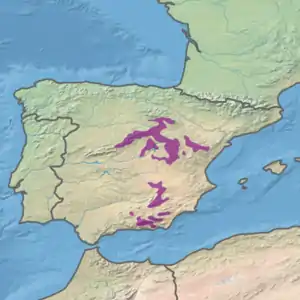Iberian conifer forests
The Iberian conifer forests is a Mediterranean forests, woodlands, and scrub ecoregion in southwestern Europe. It includes the mountain forests of southern and central Spain.
| Iberian conifer forests | |
|---|---|
.jpg.webp) Pines in the Sierra de Cazorla | |
 Ecoregion territory (in purple) | |
| Ecology | |
| Realm | Palearctic |
| Biome | Mediterranean forests, woodlands, and scrub |
| Borders | Iberian sclerophyllous and semi-deciduous forests, Northwest Iberian montane forests and Southeastern Iberian shrubs and woodlands |
| Geography | |
| Area | 34,462 km2 (13,306 sq mi) |
| Country | Spain |
| Autonomous communities of Spain | Andalucia, Aragon, Castile and León, Castile-La Mancha, Madrid, and Murcia |
| Conservation | |
| Conservation status | critical/endangered |
| Protected | 15,229 km² (44%)[1] |
The ecoregion has montane Mediterranean climate. Rainfall averages 1,100 mm annually, and can exceed 1,500 mm in some high-altitude areas. Below-freezing temperatures and snow are common in the winter months.[2]
Geography
The ecoregion covers higher elevations in several disconnected ranges in southern and central Spain.
The Sierra Nevada lies in Andalucia, overlooking the Mediterranean Sea. The Sierra de Baza lies close to the northeast.
The Sierra de Castril lies northeast of the Sierra de Baza, between the Andalucian and Iberian mountains.
The ecoregion covers the southern ranges of the Sistema Ibérico, including the Sierra de Gúdar, Sierra de Albarracín, and Sierra de Javalambre. It also includes the Sierra de Guadarrama, the eastern portion of the Sistema Central.
Flora
Pine forests are the characteristic plant community, with Black pine (Pinus nigra salzmannii), Scots pine (Pinus sylvestris), and Maritime pine (Pinus pinaster) predominant.
Mixed forests of pines and broadleaf trees grow at middle to lower elevations in areas with deeper soils and higher humidity. Broadleaf trees include Quercus faginea, Quercus pyrenaica, Ulmus glabra, Fraxinus angustifolia, lindens (Tilia spp.), Sorbus spp., and maples (Acer spp). Taxus baccata, Tilia platyphyllos, and Populus tremula grow in sheltered canyons with year-round moisture.[3]
Evergreen oaks, chiefly holm oak (Quercus ilex subsp. ballota) grow on dry and south-facing slopes at low and mid-elevations.
Fauna
Spanish red deer (Cervus elaphus hispanicus) and roe deer (Capreolus capreolus) are widespread.[4] The Western Spanish ibex (Capra pyrenaica victoriae), a threatened subspecies of goat, was reintroduced to Sierra de Guadarrama National Park in 1991 from the Gredos Mountains further west, and has increased in numbers since.[5]
The Iberian wolf (Canis lupus signatus) lives in limited numbers in the northern ranges. An isolated southern population in the Sierra Morena dwindled in numbers and interbred with dogs, and may now be extinct.[6]
Protected areas
952 km², or 35%, of the ecoregion is in protected areas.[7]
Protected areas include Sierra Nevada National Park, Serrania de Cuenca Natural Park, Sierras de Cazorla, Segura y Las Villas Natural Park, and Sierra de Guadarrama National Park.
External links
| Wikimedia Commons has media related to Iberian conifer forests. |
- "Iberian conifer forests". Terrestrial Ecoregions. World Wildlife Fund.
References
- Eric Dinerstein, David Olson, et al. (2017). An Ecoregion-Based Approach to Protecting Half the Terrestrial Realm, BioScience, Volume 67, Issue 6, June 2017, Pages 534–545; Supplemental material 2 table S1b.
- "Iberian conifer forests". Terrestrial Ecoregions. World Wildlife Fund.
- "Iberian conifer forests". Terrestrial Ecoregions. World Wildlife Fund.
- "Iberian conifer forests". Terrestrial Ecoregions. World Wildlife Fund.
- Refoyo, Pablo, Cristina Olmedo, Ignacio Polo, Paulino Fandos and Benito Muñoz (2015). "Demographic trends of a reintroduced Iberian ibex Capra pyrenaica victoriae population in central Spain". Mammalia 2015; 79(2): 139–145
- Gómez-Sánchez, Daniel; Olalde, Iñigo; Sastre, Natalia; Enseñat, Conrad; Carrasco, Rafael; Marques-Bonet, Tomas; Lalueza-Fox, Carles; Leonard, Jennifer A; Vilà, Carles; Ramírez, Oscar (2018). "On the path to extinction: Inbreeding and admixture in a declining grey wolf population". Molecular Ecology. 27 (18): 3599–3612. doi:10.1111/mec.14824. PMID 30074659.
- Eric Dinerstein, David Olson, et al. (2017). An Ecoregion-Based Approach to Protecting Half the Terrestrial Realm, BioScience, Volume 67, Issue 6, June 2017, Pages 534–545; Supplemental material 2 table S1b.